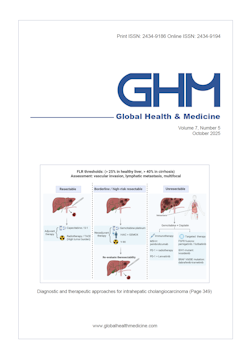Global Health & Medicine 2022;4(6):315-321.
Short- and long-term efficacy of bronchial artery embolization using a gelatin sponge for the treatment of cryptogenic hemoptysis
Nagano N, Suzuki M, Yamamoto S, Kobayashi K, Iikura M, Izumi S, Hojo M, Sugiyama H
Bronchial artery embolization (BAE) is the first choice treatment for hemoptysis. With advances in endovascular treatment, various embolic materials have become available. However, the optimal embolic material for the treatment of cryptogenic hemoptysis has not been determined. This study aimed to investigate the shortand long-term efficacy of BAE using a gelatin sponge in the treatment of patients with cryptogenic hemoptysis. The clinical characteristics, angiographic findings, and short- and long-term outcomes of BAE were retrospectively analyzed in 22 consecutive patients who underwent BAE for control of cryptogenic hemoptysis between January 2010 and September 2018. Selective angiography and super-selective BAE were successfully performed for all patients. A gelatin sponge was used in all patients. Further, polyvinyl alcohol was mixed with the gelatin sponge in 11 patients (50%). Angiography showed that the bronchial artery was responsible for hemoptysis in all patients, along with the intercostal artery in one patient (4.5%) and the inferior phrenic artery in one patient (4.5%). Immediate hemostasis was achieved in all patients. The recurrence-free rate was 100% for 1 month, 94.1% for 3 months, 94.1% for 12 months, and 87.4% for 24 months. Of two patients with recurrent hemoptysis, one underwent bronchoscopic hemoptysis and the other received intravenous hemostatic agents. No patient underwent BAE for recurrence. No severe complications occurred. In conclusion, BAE using a gelatin sponge has short- and long-term hemostatic efficacy for treating cryptogenic hemoptysis without any severe complications. A gelatin sponge is a suitable embolic material for patients with cryptogenic hemoptysis.
DOI: 10.35772/ghm.2022.01057







